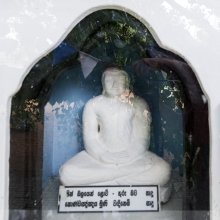Kondanna, Koṇḍañña: 2 definitions
Introduction:
Kondanna means something in Buddhism, Pali. If you want to know the exact meaning, history, etymology or English translation of this term then check out the descriptions on this page. Add your comment or reference to a book if you want to contribute to this summary article.
Images (photo gallery)
In Buddhism
Theravada (major branch of Buddhism)
Source: Pali Kanon: Pali Proper Names1. Kondanna - The second of the twenty four Buddhas.
After sixteen asankheyya and one hundred thousand kappas of parami,
he was born in Rammavati,
his father being King Sunanda and his mother Sujata.
He belonged to the Kondannagotta and
his body was twenty eight cubits in height.
For ten thousand years he lived as a layman in three palaces - Ruci, Suruci and Subha (Rama, Surama and Subha, according to BuA);
his chief wife was Rucidevi and his son Vijitasena.
He left home in a chariot,
practised austerities for ten months and
was given a meal of milk rice by Yasodhara,
daughter of a merchant in Sunanda, and
grass for his seat by the Ajivaka Sunanda.
His bodhi was a Salakalyani tree, and
his first sermon was preached to ten crores of monks in the Devavana near Amaravati.
He held three assemblies of his disciples, the first led by Subhadda, the second by Vijitasena and the third by Udena, all of whom had become arahants.
He died at the age of one hundred thousand at Candarama, and
the thupa erected over his relics was seven leagues in height.
His chief disciples were Bhadda and Subhadda among monks,
and Tissa and Upatissa among nuns,
his constant attendant being Anuruddha.
His chief patrons were Sona and Upasona among laymen and Nanda and Sirima among laywomen.
The Bodhisatta was a king, Vijitavi of Candavati. He left his kingdom, joined the Order and was later reborn in the Brahma world. Bu.iii.; BuA.107ff; J.i.30.
2. Kondanna - The name of a gotta.
It was evidently common to both brahmans and khattiyas, for we find the brahman Annata Kondanna belonging to it, and elsewhere (E.g., VibbA.464) it is mentioned as a khattiyagotta.
Among those mentioned as belonging to the Kondanna gotta are:
Buddha Kondanna (brahmin),
Candakumara (J.vi.137, 138) (khattiya),
Sarabhanga (J.v.140,141, 142) (brahmin),
the three Buddhas Vipassi, Sikhi and Vessabhu, all khattiyas (D.ii.3ff, see table in Dial.16).
In the Kacchapa Jataka (J.ii.360f) it is said that tortoises are of the Kassapa gotta and monkeys of the Kondanna gotta, and that between these two classes there is intermarriage.
3. Kondanna - The name of the apprentice in the Varuni Jataka.
4. Kondanna - See also Annata Kondanna, Vimala Kondanna and Khanu Kondanna.
Theravāda is a major branch of Buddhism having the the Pali canon (tipitaka) as their canonical literature, which includes the vinaya-pitaka (monastic rules), the sutta-pitaka (Buddhist sermons) and the abhidhamma-pitaka (philosophy and psychology).
Languages of India and abroad
Pali-English dictionary
Source: Sutta: The Pali Text Society's Pali-English DictionaryKoṇḍañña, a well-known gotta J. II, 360. (Page 228)

Pali is the language of the Tipiṭaka, which is the sacred canon of Theravāda Buddhism and contains much of the Buddha’s speech. Closeley related to Sanskrit, both languages are used interchangeably between religions.
See also (Relevant definitions)
Starts with: Kondanna Sutta.
Ends with: Annata Kondanna, Dathakondanna, Khanu Kondanna, Vimalakondanna.
Full-text (+22): Yanna, Rucidevi, Kondanna Sutta, Candarama, Sunandaka, Tathagatena Vutta Sutta, Sankamanatta Theri, Abbhanjanadayaka, Surama, Nissenidayaka, Rammavati, Annata Kondanna, Amaravati, Kakudha Sutta, Five Bhikkhus, Adicca, Ajnatakaundinya, Dhammacakkappavattana Sutta, Pancavaggiya, Twenty Eight Buddhas.
Relevant text
Search found 15 books and stories containing Kondanna, Koṇḍañña; (plurals include: Kondannas, Koṇḍaññas). You can also click to the full overview containing English textual excerpts. Below are direct links for the most relevant articles:
The Wheel Of The Dhamma Begins To Turn < [Forty-five Years Of Teaching]
The Noble Sangha Is Born < [Forty-five Years Of Teaching]
The Dawn of the Dhamma (by Sucitto Bhikkhu)
Chapter 25 - The One Who Knows < [The Sutta]
Introduction < [The Sutta]
Chapter 16 - What Kondanna Knew < [The Sutta]
The Gospel of Buddha (by Paul Carus)
The Great Chronicle of Buddhas (by Ven. Mingun Sayadaw)
Buddha Chronicle 2: Koṇḍañña Buddhavaṃsa < [Chapter 9 - The chronicle of twenty-four Buddhas]
Biography (1) Koṇḍañña Mahāthera < [Chapter 43 - Forty-one Arahat-Mahatheras and their Respective Etadagga titles]
Part 16 - Notes on the Dhammacakka-pavattana Sutta < [Chapter 42 - The Dhamma Ratanā]
Banner of the Arahants (by Bhikkhu Khantipalo)
Part 1 - Discourse On Setting In Motion The Wheel Of Dhamma < [Appendix I]
Chapter 1 - The Buddha: Unsurpassed Perfect Enlightenment
Dhammapada (Illustrated) (by Ven. Weagoda Sarada Maha Thero)
Verse 111 - The Story of Khānu-Koṇḍañña < [Chapter 8 - Sahassa Vagga (Thousands)]
Verse 353 - The Story of Upaka < [Chapter 24 - Taṇhā Vagga (Craving)]
Verse 186-187 - The Story of a Discontented Young Monk < [Chapter 14 - Buddha Vagga (The Buddha)]
